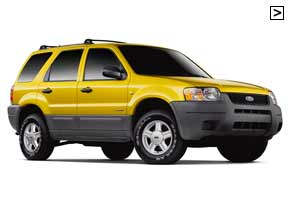
SAN FRANCISCO: The Ford
Explorer helped launch the sport utility vehicle explosion of the 1990s. But Toyota,
Honda, and Kia, among others, created a healthy market for smaller SUVs, sometimes
referred to as "cute utes." Seeing an opportunity, Ford now has one too.
With a brand new, larger 2002 Explorer in the wings, Ford introduced its 2001 Escape
last fall, with high hopes for another home run. Ford gave the compact Escape some things
to help it do battle against the import brands.
First of all, they gave the Escape a name beginning with an "E." That links
it to a family that includes the Explorer, the larger Expedition and the behemoth
three-and-a-half-ton Excursion.
Secondly, the designers gave the Escape a strong family resemblance to the Explorer.
Why go far afield when you already have a winner? The upright, chunky SUV profile is all
there, slightly updated for the 21st century. Scuff-resistant cladding covers the front
fascia, rear bumper, and lower body panels. The wheel wells bulge out, and a deep fold
runs between them to impart thickness and strength. A wide stance and bold wheels wearing
off road tires say "truck." A roof rack comes as standard equipment.
Thirdly, the Escape is significantly smaller than the Explorer, but Ford engineers made
it a little bigger than its competition. The Escape's 133.9 cubic feet of interior
capacity is the largest in its class. The engineers designed fold-flat rear seats for
useful cargo hauling service. Human beings will appreciate the tall ceiling and generous
legroom, too.
Fourth, Ford offered a class exclusive, an optional 3.0-liter, 200-horsepower V6
engine. My tester was so equipped, and although it is not the world's quietest engine, it
propels the little SUV onto freeways and through quick passing maneuvers as if it sat on a
cactus. Mileage figures are 18 city, 24 highway.
The standard 2.0-liter Zetec four-cylinder engine puts out 127 horsepower, which is
typical of the import competition, and earns the 3,300-pound Escape mileage ratings of 23
city, 28 highway with two wheel drive.
The designers went to great lengths to give the Escape a feeling of quality, strength,
and beauty. For example, they spent time and energy designing the perfect outside door
handle, blending truck ruggedness with car sophistication.
Another style consideration was painting the rear differential, drive shaft and lateral
links flat black so drivers following an Escape will find the view harmonious. The Escape
is a very pleasant commuter. Its car like unibody construction and four-wheel independent
suspension help it drive like a tall car rather than a truck. The side body panels are
stamped in single sections that encompass the door openings to minimize vibration and
create a better quality door fit.
The interior mixes a rugged, blocky truck ambiance with nicely rendered details to
induce a sense of quality and comfort. The high-mounted radio and climate controls are
easy to reach and operate. In my tester, the grab handles attached to the front window
pillars didn't blend into the surrounding plastic very well, but otherwise the inside
looked and felt very cozy.
The front buckets are firm for a Ford, and comfortable, too. The engineers used
"anthroprometric" data (a fancy way of saying they measured a bunch of people
and asked their opinion) to build seats that can accommodate the widest possible range of
drivers.
The rear cargo area holds 33 cubic feet of your stuff with the seats up. A week's worth
of groceries disappeared into it with ease. With the rear seats folded down, you could go
buy furniture at Ikea.
Escapes come in two models, the XLS base model and the XLT upper series. Both have
front-wheel drive standard, with four-wheel drive optional. Because many people want the
sporty off road look rather than the actual experience, you can save money by getting a
two-wheel-drive version, and no one is the wiser. My test unit was a perfect example, with
two-wheel-drive in an XLT model.
The optional four-wheel-drive system is called Control Trac II. When set in the 4x4
Auto position, it automatically proportions torque to the rear wheels when the fronts
start to slip. And, for the few rugged outdoor persons, the 4x4 On feature locks the front
and rear axles together for a Jeep like 50/50 torque split.
The up level XLT gets standard power windows, mirrors, and locks with a remote. Also
standard are air conditioning, variable speed wipers, rear window defogger and wiper,
AM/FM stereo with cassette and CD slots, too. That's a nice list of equipment for $19,195.
My tester also came with options, most notably the 3.0-liter engine ($1,480) and the
Comfort Group ($870), which includes an overhead console, perforated leather-wrapped
steering wheel, and leather seats with six-way adjustment for the driver. Stylish and
practical side step bars ($275), an upgraded stereo system ($505), fancier alloy wheels
($175) and the safety of side airbags ($345) brought the grand total to $23,635.
The Escape felt like the kind of SUV a small family could fill with all their gear and
lots of happy memories for many years of fun activities. By Steve Schaefer ©
AutoWire.Net - San Francisco

Ford Home Page
Byline: Syndicated content provided by Tony Leopardo ©
AutoWire.Net
Column Name: "A new compact SUV from Ford"
Topic: 2001 Ford Escape
Word Count: 912
Photo Caption: 2001 Ford Escape
Photo Credits: Ford Internet Media
Series #: 2001 - 29
Download the Microsoft Word version here: 2001 Ford Escape
Download the original image file here: 2001 Ford Escape 7k


|
